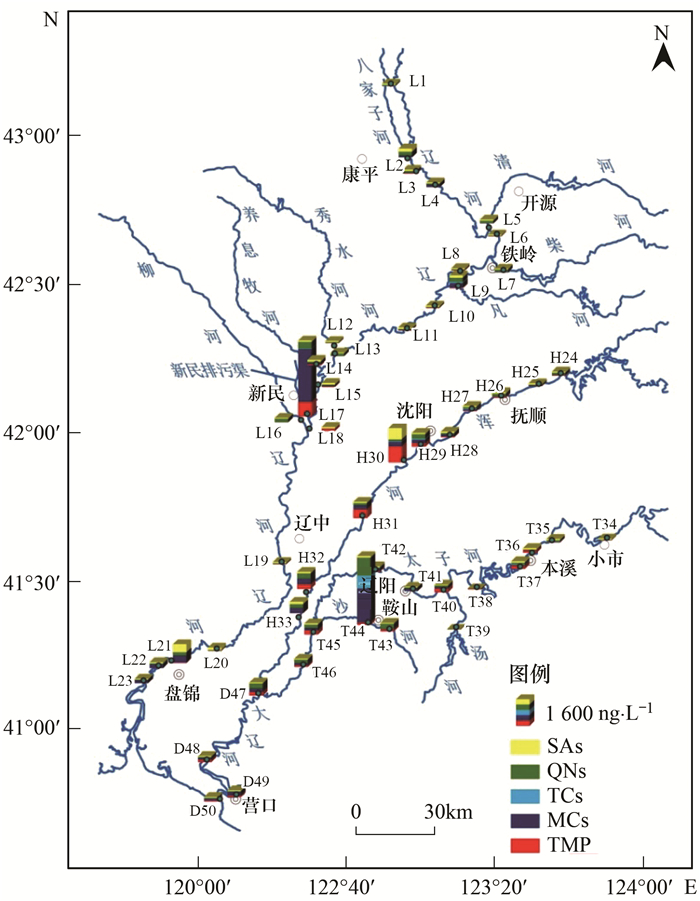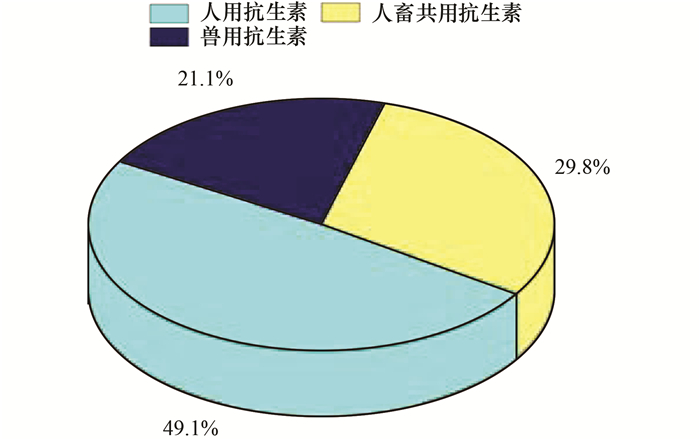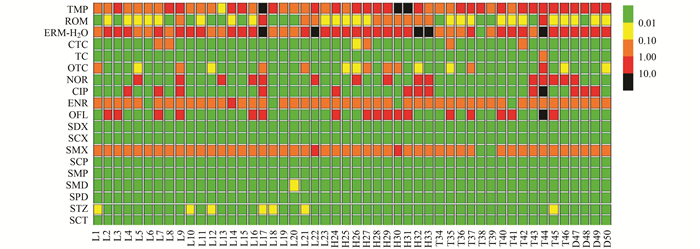2. 中国环境科学研究院流域水生态保护技术研究室, 北京 100012;
3. 辽宁大学环境学院, 沈阳 110036
2. Laboratory of Riverine Ecological Conservation and Technology, Chinese Research Academy of Environmental Sciences, Beijing 100012, China;
3. School of Environmental Sciences, Liaoning University, Shenyang 110036, China
抗生素是药物和个人护理品中的一类, 具有抗菌活性, 是生物在生命活动过程中所产生或者半人工合成、全人工合成, 能在低微浓度下有选择地抑制或影响生物机能的化合物[1], 其最初用于人类和牲畜疾病防治, 后又作为促增长剂广泛应用于畜牧业.我国作为抗生素的“世界工厂”, 生产和使用的抗生素远远高于其他国家已报道的使用量. 2013年我国抗生素的消费量约为16万t, 其中48%为人用抗生素, 52%为兽用抗生素, 我国平均每1 000人每天使用抗生素的量是英国的6倍以上, 抗生素的消费总量是英国的150多倍[2].抗生素在我国不仅使用量大, 而且缺乏规范的指导和监督, 兽用与农用抗生素滥用状况严重, 门诊患者抗生素使用率高达75%, 远远大于世界卫生组织抗生素平均使用率应低于30%的要求[3].
人类生产和使用的抗生素会通过污水处理厂、垃圾场渗滤液和农田施用后的雨水冲刷等途径进入水环境, 水环境中的抗生素与人类活动密不可分, 抗生素的半衰期虽然较持久性有机污染物短, 但是由于人类的大量使用加之其进入生物体内后未能被使用或代谢完全, 其中大部分以原药的形式被生物体排出体外, 导致其在水环境中呈现一种“假持久性”[4].水环境中残留的抗生素不仅会对水生生物产生毒性, 影响水生生态系统, 而且会诱导产生抗性细菌, 甚至威胁人类健康[5], 其可能造成的生态风险已经受到国内外学者的广泛关注[6, 7].
辽河流域内辽宁省城市化程度高, 人口众多, 养殖业发达, 更有国家重点监控抗生素生产企业, 大量含抗生素的废水会极大地影响辽河流域水体中抗生素含量[8].目前, 对于我国河流地表水中抗生素的研究大部分集中在东南部, 其中包括海河流域和渤海湾, 长江流域下游及其三角洲, 珠江流域和维多利亚湾[9~13].辽河流域全流域的抗生素污染状况和生态风险的研究还相对较少[14], 因此本文以辽河流域地表水为研究对象, 分析5类21种典型抗生素在该流域的污染特征, 并利用风险商值法(RQs)评估流域内抗生素的生态风险, 以期为流域内抗生素污染控制与环境治理提供有效的数据基础.
1 材料与方法 1.1 采样点设置辽河流域位于我国东北地区, 由辽河水系(L1~L23) 和大辽河水系两大水系(H24~D50) 组成, 研究围绕重要的城市, 可能的污染源, 重要的支流及大型水利设施布设50个采样点(详见图 1), 采集表层水样, 时间为2012年5月.

|
图 1 辽河流域各采样点抗生素的含量与分布 Fig. 1 Distribution of antibiotics from different sampling points of the Liaohe River Basin |
根据抗生素在我国的使用特征及国内外学者已有的研究成果[15, 16], 本文选取5类(磺胺类SAs、喹诺酮类QNs、四环素类TCs、大环内酯类MCs和磺胺增效剂TMP)21种典型抗生素为研究对象.其中10种磺胺类抗生素:磺胺醋酰Sulfacetamide(SCT)、磺胺噻唑Sulfathiazole(STZ)、磺胺吡啶Sulfapyridine(SPD)、磺胺甲基嘧啶Sulfamerazine(SMA)、磺胺氯哒嗪Sulfachloropyridazine(SCP)、磺胺二甲嘧啶Sulfadimidine(SMD)、磺胺甲噁唑Sulfamethoxazole(SMX)、磺胺二甲氧哒嗪Sulfadimethoxine(SDX)、磺胺喹恶啉Sulfachinoxaline(SCX)、磺胺甲氧嗪Sulfamethoxypyridazine(SMP); 4种喹诺酮类抗生素:恩氟沙星Enrofloxacin(ENR)、氧氟沙星Ofloxacin(OFL)、诺氟沙星Norfloxacin(NOR)、环丙沙星Ciprofloxacin(CIP); 3种四环素类抗生素:四环素Tetracycline(TC)、氧四环素Oxytetracycline(OTC)、氯四环素Chlortetracycline(CTC); 3种大环内酯类抗生素:红霉素Erythromycin(ERM)、泰乐霉素Tylosin(TYL)、罗红霉素Roxithromycin(ROM)和一种磺胺增效剂, 甲氧苄氨嘧啶Trimethoprim(TMP).红霉素(ERM)在水环境中相对不稳定, 在酸性条件下, 容易脱去一个水分子而变为脱水红霉素(ERM-H2O), 所以检测脱水红霉素(ERM-H2O)在环境介质中的浓度.
用不锈钢桶在采样点附近采集表层水样3次混合, 放入聚丙烯采样瓶, 低温保存, 48小时内放入冰柜中冷藏, 并尽快处理.
取1 L水样用稀硫酸调pH=3, 过47 mm滤膜(GF/F, Whatman, Maidstone, England), 加入1.2 g Na2EDTA和50 ng标准替代物(CIP-D8, SAM-13C6, ERM-13C和TRM-13C3)后固相萃取. Oasis HLB固相萃取柱串联固相萃取装置, 用5 mL甲醇和5 mL高纯水活化, 再加入5 mL高纯水保持柱内湿润, 打开真空泵调节流速为5~10 mL·min-1, 当水样品完全过HLB柱后, 用5 mL 10%的甲醇稀溶液和5 mL高纯水依次清洗HLB柱, 流出液全部弃去.在65 kPa负压下, 抽干HLB柱, 用6 mL甲醇淋洗, 收集洗脱液于试管中, 在30℃下将洗脱液氮吹至0.5 mL以下, 然后将浓缩液转移至质谱小瓶, 用甲醇定容为1.0 mL保存待测.
1.3 仪器分析仪器采用为Agilent Zorbax Eclipse XDB-C18(4.6 mm×150 mm, 5 μm)色谱分析柱; 流动相A和流动相B分别为乙腈和0.1%的甲酸溶液; 设定检测波长为254 nm, 参照波长为270 nm, 色谱柱温度为30℃, 流速为0.30 mL·min-1; 样品进样量为10 μL.采用多反应选择监测(multiple reaction monitoring, MRM)模式检测, 40 psi雾化器压强, 电喷雾电离源(ESI), 正离子扫描, 4 000 V毛细管电压.干燥气流速和温度为8 L·min-1和350℃.
1.4 质量控制所有分析数据的获得均严格执行QA/QC程序, 方法空白用来控制整个实验过程中是否有人为或环境因素所带来的污染; 空白加标用于控制整个实验过程的准确性.每次测定样品前均重新配制工作液作标准曲线, 前后两次相差均不超过10%.结果显示地表水抗生素回收率在64.7%~102.0%.
1.5 来源解析与风险评估方法 1.5.1 来源解析方法抗生素根据使用对象不同可分为人用抗生素、兽用抗生素和人畜共用抗生素三类, 不同种类的抗生素使用类型详见表 1[17~19].本研究采用主成分分析结合多元线性回归PCA-MLR方法判定辽河流域内抗生素的来源.
|
|
表 1 典型抗生素的使用类型 Table 1 Typical antibiotic pollutants |
利用PCA-MLR计算得出各主成分回归系数Bi, 再用Bi/ΣBi计算每个源的平均贡献比率[20], 即污染源所占的比例.计算公式如下:

|
式中, Bi代表方程的回归系数; FSi指PCA计算的因子得分; 
利用风险熵值法(risk quotients, RQs)评估生态风险, RQs可以通过风险阈值PNEC与水环境中抗生素的检测浓度MEC的比值获得:

|
式中, LC50为半致死浓度; EC50为半效应浓度; LOEC为最低效应浓度; NOEC为最低无效应浓度; AF为评价因子.根据欧盟的技术指导文件(TGD)中评价因子根据生物毒性数据情况选取, 急性毒性数据AF取1 000;当慢性毒性数据满足3个营养级时, AF取10;满足两个营养级时AF取50;满足一个营养级时, AF取100.
根据Hernando等[4]提出的RQs分类方法来评估生态风险等级:低风险(0.01≤RQs<0.1), 中等风险(0.1≤RQs<1), 高风险(RQs≥1).
2 结果与讨论 2.1 辽河流域抗生素污染特征 2.1.1 抗生素浓度水平辽河流域地表水中抗生素广泛存在, 21种抗生素中仅有SMA和TYL未检出, 抗生素浓度水平如表 2所示.流域内抗生素平均浓度最高为大环内酯类201.88 ng·L-1; 其次为喹诺酮类124.27 ng·L-1, 甲氧苄氨嘧啶113.40 ng·L-1, 磺胺类93.93 ng·L-1和四环素类24.37 ng·L-1.
|
|
表 2 辽河流域地表水中抗生素的浓度与检出率(N=50) Table 2 Concentration and detection rates of antibiotics in the surface water of the Liaohe River Basin(N=50) |
水样品中大环内酯类所占抗生素的比例为36.2%, 检出率为98%, 其中ERM-H2O和ROM平均浓度分别为165.41 ng·L-1和36.47 ng·L-1. ERM-H2O和ROM是我国水环境中最常检测到的大环内酯类抗生素, 但是在欧洲和加拿大克拉霉素Clarithromycin才是最常见的大环内酯类抗生素, 说明在不同国家和地区抗生素使用类型有一定的差异[21].喹诺酮类所占比例为22.3%, 其中ENR检出率最高为92%, 平均浓度25.72 ng·L-1, OFL、NOR和CIP的检出率不高, 分别为36%、30%和26%, OFL和NOR虽然检出率大大低于ENR, 但是其平均浓度37.93 ng·L-1和49.03 ng·L-1却高于ENR, 说明其在个别点位有较高的浓度.因大部分喹诺酮类具有很强的吸附能力, 较易吸附在河流的沉积物或悬浮物上[22], 故其在水样品中的检出率较低. TMP是一种磺胺增效剂, 所占比例20.3%, 浓度范围为2.9~976.10 ng·L-1, 检出率100%.磺胺类所占比例16.8%, 平均浓度93.93 ng·L-1, 检出率100%, 其中SMX平均浓度为84.90 ng·L-1, 远高于其他磺胺类抗生素的使用水平.四环素类所占的比例最低, 仅为4.4%, 其中除OTC的检出率与平均浓度相比较高些, TC和CTC相对较低, 极强的吸附性以及易于与阳离子结合是导致这一现象的主要原因[23].
辽河流域地表水中抗生素的浓度与国内外研究结果相比ERM-H2O、ROM和TMP污染较为严重, 其最大浓度要高于国内外河流, 其余几种抗生素浓度范围与国内外河流相比处于中等水平(表 3).
|
|
表 3 国内外地表水中抗生素浓度比较1) Table 3 Comparison of concentrations of antibiotics in global surface water |
2.1.2 抗生素空间分布
辽河流域地表水中抗生素的空间分布遵循河流的上游污染水平低于下游, 城市段浓度水平高于郊区和农村的规律, 这与杨常青等的研究一致[14].大辽河水系抗生素平均总浓度622.25 ng·L-1要明显高于辽河水系抗生素平均总浓度482.28 ng·L-1, 主要原因是辽河水系流经城市较少, 且辽河干流划定了保护区, 保护区对改善水质和防护污染起到了积极的作用.大辽河水系中浑河抗生素含量要高于太子河和大辽河, 这与其流经抚顺和沈阳两大城市, 人口众多, 抗生素使用量大, 并且有抗生素生产制造企业排放大量抗生素废水有关.辽河水系(L1~L23,图 1), 除L12秀水河点位抗生素浓度低于其汇入点的浓度, 其他所有支流中抗生素的浓度均高于其汇入点的浓度, 说明辽河干流中的抗生素污染主要来源于支流.
流域内抗生素污染较为严重的点位为L17、H30和T44. L17是新民市排水渠为流域内抗生素总浓度最高的点位4 532.23 ng·L-1, 其流量较小但污染严重, H30和T44均在沈阳市和鞍山市城市污水处理厂排污口附近, 表明在人口密集的城市区域, 生活污水的排放是河流抗生素的主要来源.
2.2 抗生素来源解析本研究采用PCA-MLR方法分析辽河流域内抗生素的来源组成, PCA分析结果如表 4所示, 黑体字表示此类抗生素在这种主成分中载荷最大, 由此可知主成分1主要为OFL、CIP、OTC和ROM; 主成分2为SMP和ERM-H2O; 主成分3为NOR; 主成分4为SMX和TMP; 主成分5为SMD和ENR; 主成分6为SCP和CTC.对照表 1可知, 主成分1和4为人用抗生素, 主成分5和6为兽用抗生素, 主成分2和3为人畜共用抗生素.
|
|
表 4 辽河流域地表水中抗生素主成分分析法分析结果1) Table 4 Analysis of principal component analysis of the surface water in the Liaohe River Basin |
以因子得分变量为自变量, 以标准化的抗生素总量为因变量, 经SPSS软件多元线性回归得:

|
每个源的平均贡献比率可以用Bi/ΣBi计算可得, 如图 2所示, 辽河流域地表水抗生素来源组成中人用抗生素所占比例最高为49.1%, 兽用抗生素占21.1%, 人畜共用抗生素占29.8%.源解析结果表明流域内人用抗生素的使用量较大, 因此应规范人用抗生素的使用和排放.

|
图 2 辽河流域地表水中抗生素来源组成 Fig. 2 Sources of antibiotics in surface water in the Liaohe River Basin |
抗生素对水生生物急性/慢性毒性数据来源于EPA的ECOTOX数据库和CNKI的相关文献, 缺少毒性数据的用美国环保署Ecosar软件补充, 共收集163个数据, 从中筛选最低急性和慢性毒性数据, 利用毒性数据与相应的评价因子计算抗生素的PNEC值, 结果见表 5.
|
|
表 5 抗生素对应最敏感物种的毒理数据1) Table 5 Toxicity data of antibiotics to the most sensitive aquatic species |
根据计算出的RQs, 做出辽河流域地表水中抗生素的风险热度图(图 3), 从中可以看出高风险抗生素种类为ERM-H2O和TMP, 高风险点位占比分别为66%和58%.流域内高生态风险点位为新民市(L17)、沈阳市城市段(H31~H33) 和鞍山市(T44).综上所述, 辽河流域地表水中部分抗生素和部分城市点位已存在较高的生态风险, 应引起重视并采取防控措施.

|
图 3 辽河流域地表水中抗生素RQs值 Fig. 3 Risk quotients for antibiotics in the surface water of Liaohe River Basin |
(1) 辽河流域地表水中21种抗生素, 除SMA和TYL外均有检出, 大环内酯类为主要污染物, 平均浓度为201.88 ng·L-1, 四环素类浓度水平最低为24.37 ng·L-1, 与国内外其他河流相比ERM-H2O、ROM和TMP浓度较高, 其他抗生素浓度处于中等水平.大辽河水系(L1~L23) 抗生素污染水平要高于辽河水系(H24~D50).
(2) 采用主成分分析结合多元线性回归方法进行辽河流域抗生素污染物来源解析, 结果表明主要抗生素污染物为人用抗生素, 所占比例为49.1%.
(3) 生态风险评估结果表明高风险的抗生素类别为ERM-H2O和TMP, 高风险的区域为新民、沈阳和鞍山城市点位; 流域内地表水抗生素已存在一定的风险, 应引起重视并采取相应防范措施.
| [1] | Kemper N. Veterinary antibiotics in the aquatic and terrestrial environment[J]. Ecological Indicators, 2008, 8(1): 1-13. DOI:10.1016/j.ecolind.2007.06.002 |
| [2] | 张芊芊. 中国流域典型新型有机污染物排放量估算、多介质归趋模拟及生态风险评估[D]. 广州: 中国科学院研究生院(广州地球化学研究所), 2015. http://www.irgrid.ac.cn/handle/1471x/1104001?mode=full&submit_simple=Show+full+item+record |
| [3] | 郑英丽, 周子君. 抗生素滥用的根源、危害及合理使用的策略[J]. 医院管理论坛, 2007, 24(1): 23-27. |
| [4] | Hernando M D, Mezcua M, Fernández-Alba A R, et al. Environmental risk assessment of pharmaceutical residues in wastewater effluents, surface waters and sediments[J]. Talanta, 2006, 69(2): 334-342. DOI:10.1016/j.talanta.2005.09.037 |
| [5] | Sanderson H, Johnson D J, Reitsma T, et al. Ranking and prioritization of environmental risks of pharmaceuticals in surface waters[J]. Regulatory Toxicology and Pharmacology, 2004, 39(2): 158-183. DOI:10.1016/j.yrtph.2003.12.006 |
| [6] | Sapkota A, Sapkota A R, Kucharski M, et al. Aquaculture practices and potential human health risks:current knowledge and future priorities[J]. Environment International, 2008, 34(8): 1215-1226. DOI:10.1016/j.envint.2008.04.009 |
| [7] | Yang J F, Ying G G, Zhao J L, et al. Spatial and seasonal distribution of selected antibiotics in surface waters of the Pearl Rivers, China[J]. Journal of Environmental Science and Health, Part B:Pesticides, Food Contaminants, and Agricultural Wastes, 2011, 46(3): 272-280. DOI:10.1080/03601234.2011.540540 |
| [8] | Larsson J D G, Fick J. Transparency throughout the production chain-a way to reduce pollution from the manufacturing of pharmaceuticals?[J]. Regulatory Toxicology and Pharmacology, 2009, 53(3): 161-163. DOI:10.1016/j.yrtph.2009.01.008 |
| [9] | Hu W. The Study on Occurrence and distribution of typical pharmaceuticals and personal care products (PPCPs) in Tianjin urban aqueous and soil environment and the combined estrogenic effects[D]. Tianjin:The College of Environmental Science and Engineering of Nankai University, 2011. |
| [10] | Zou S C, Xu W H, Zhang R J, et al. Occurrence and distribution of antibiotics in coastal water of the Bohai Bay, China:impacts of river discharge and aquaculture activities[J]. Environmental Pollution, 2011, 159(10): 2913-2920. DOI:10.1016/j.envpol.2011.04.037 |
| [11] | Chang X S, Meyer M T, Liu X Y, et al. Determination of antibiotics in sewage from hospitals, nursery and slaughter house, wastewater treatment plant and source water in Chongqing region of Three Gorge Reservoir in China[J]. Environmental Pollution, 2010, 158(5): 1444-1450. DOI:10.1016/j.envpol.2009.12.034 |
| [12] | Peng X Z, Tan J H, Tang C M, et al. Multiresidue determination of fluoroquinolone, sulfonamide, trimethoprim, and chloramphenicol antibiotics in urban waters in China[J]. Environmental Toxicology and Chemistry, 2008, 27(1): 73-79. DOI:10.1897/06-650.1 |
| [13] | Minh T B, Leung H W, Loi I H, et al. Antibiotics in the Hong Kong metropolitan area:ubiquitous distribution and fate in Victoria Harbour[J]. Marine Pollution Bulletin, 2009, 58(7): 1052-1062. DOI:10.1016/j.marpolbul.2009.02.004 |
| [14] |
杨常青, 王龙星, 侯晓虹, 等. 大辽河水系河水中16种抗生素的污染水平分析[J]. 色谱, 2012, 30(8): 756-762. Yang C Q, Wang L X, Hou X H, et al. Analysis of pollution levels of 16 antibiotics in the river water of Daliao River water system[J]. Chinese Journal of Chromatography, 2012, 30(8): 756-762. |
| [15] | Bu Q W, Wang B, Huang J, et al. Pharmaceuticals and personal care products in the aquatic environment in China:A review[J]. Journal of Hazardous Materials, 2013, 262: 189-211. DOI:10.1016/j.jhazmat.2013.08.040 |
| [16] | Na G S, Fang X D, Cai Y Q, et al. Occurrence, distribution, and bioaccumulation of antibiotics in coastal environment of Dalian, China[J]. Marine Pollution Bulletin, 2013, 69(1-2): 233-237. DOI:10.1016/j.marpolbul.2012.12.028 |
| [17] | Kim S C, Carlson K. LC-MS2 for quantifying trace amounts of pharmaceutical compounds in soil and sediment matrices[J]. TrAC Trends in Analytical Chemistry, 2005, 24(7): 635-644. DOI:10.1016/j.trac.2005.04.006 |
| [18] | Luo Y, Xu L, Rysz M, et al. Occurrence and transport of tetracycline, sulfonamide, quinolone, and macrolide antibiotics in the Haihe River Basin, China[J]. Environmental Science & Technology, 2011, 45(5): 1827-1833. |
| [19] | Xu J, Zhang Y, Zhou C B, et al. Distribution, sources and composition of antibiotics in sediment, overlying water and pore water from Taihu Lake, China[J]. Science of the Total Environment, 2014, 497-498: 267-273. DOI:10.1016/j.scitotenv.2014.07.114 |
| [20] | 章琴琴. 北京温榆河流域抗生素污染分布特征及源解析研究[D]. 重庆: 重庆大学, 2012. http://d.wanfangdata.com.cn/Thesis/Y2152818 |
| [21] | Göbel A, Thomsen A, McArdell C S, et al. Occurrence and sorption behavior of sulfonamides, macrolides, and trimethoprim in activated sludge treatment[J]. Environmental Science & Technology, 2005, 39(11): 3981-3989. |
| [22] | Duong H A, Pham N H, Nguyen H T, et al. Occurrence, fate and antibiotic resistance of fluoroquinolone antibacterials in hospital wastewaters in Hanoi, Vietnam[J]. Chemosphere, 2008, 72(6): 968-973. DOI:10.1016/j.chemosphere.2008.03.009 |
| [23] | Figueroa R A, Mackay A A. Sorption of oxytetracycline to iron oxides and iron oxide-rich soils[J]. Environmental Science & Technology, 2005, 39(17): 6664-6671. |
| [24] | Li W, Shi Y, Gao L, et al. Occurrence of antibiotics in water, sediments, aquatic plants, and animals from Baiyangdian Lake in North China[J]. Chemosphere, 2012, 89(11): 1307-1315. DOI:10.1016/j.chemosphere.2012.05.079 |
| [25] | Na G S, Gu J, Ge L L, et al. Detection of 36 antibiotics in coastal waters using high performance liquid chromatography-tandem mass spectrometry[J]. Chinese Journal of Oceanology and Limnology, 2011, 29(5): 1093-1102. DOI:10.1007/s00343-011-0225-1 |
| [26] | Jiang L, Hu X L, Yin D Q, et al. Occurrence, distribution and seasonal variation of antibiotics in the Huangpu River, Shanghai, China[J]. Chemosphere, 2011, 82(6): 822-828. DOI:10.1016/j.chemosphere.2010.11.028 |
| [27] | Tamtam F, Mercier F, Le Bot B, et al. Occurrence and fate of antibiotics in the Seine River in various hydrological conditions[J]. Science of the Total Environment, 2008, 393(1): 84-95. DOI:10.1016/j.scitotenv.2007.12.009 |
| [28] | Kim S C, Carlson K. Temporal and spatial trends in the occurrence of human and veterinary antibiotics in aqueous and river sediment matrices[J]. Environmental Science & Technology, 2007, 41(1): 50-57. |
| [29] | Watkinson A J, Murby E J, Kolpin D W, et al. The occurrence of antibiotics in an urban watershed:from wastewater to drinking water[J]. Science of the Total Environment, 2009, 407(8): 2711-2723. DOI:10.1016/j.scitotenv.2008.11.059 |
| [30] | Pro J, Ortiz J A, Boleas S, et al. Effect assessment of antimicrobial pharmaceuticals on the aquatic plant Lemna minor[J]. Bulletin of Environmental Contamination and Toxicology, 2003, 70(2): 290-295. DOI:10.1007/s00128-002-0208-1 |
| [31] | Park S, Choi K. Hazard assessment of commonly used agricultural antibiotics on aquatic ecosystems[J]. Ecotoxicology, 2008, 17(6): 526-538. DOI:10.1007/s10646-008-0209-x |
| [32] | Park K, Kwak I S. Gene expression of ribosomal protein mRNA in Chironomus riparius:effects of endocrine disruptor chemicals and antibiotics[J]. Comparative Biochemistry and Physiology Part C:Toxicology & Pharmacology, 2012, 156(2): 113-120. |
| [33] | Quinn B, Gagné F, Blaise C, et al. An investigation into the acute and chronic toxicity of eleven pharmaceuticals (and their solvents) found in wastewater effluent on the cnidarian, Hydra attenuata[J]. Science of the Total Environment, 2008, 389(2-3): 306-314. DOI:10.1016/j.scitotenv.2007.08.038 |
| [34] | Brain R A, Johnson D J, Richards S M, et al. Effects of 25 pharmaceutical compounds to Lemna gibba using a seven-day static-renewal test[J]. Environmental Toxicology and Chemistry, 2004, 23(2): 371-382. DOI:10.1897/02-576 |
| [35] | Yang L H, Ying G G, Su H C, et al. Growth-inhibiting effects of 12 antibacterial agents and their mixtures on the freshwater microalga Pseudokirchneriella subcapitata[J]. Environmental Toxicology and Chemistry, 2008, 27(5): 1201-1208. DOI:10.1897/07-471.1 |
| [36] | De Liguoro M, Fioretto B, Poltronieri C, et al. The toxicity of sulfamethazine to Daphnia magna and its additivity to other veterinary sulfonamides and trimethoprim[J]. Chemosphere, 2009, 75(11): 1519-1524. DOI:10.1016/j.chemosphere.2009.02.002 |
| [37] | Isidori M, Lavorgna M, Nardelli A, et al. Toxic and genotoxic evaluation of six antibiotics on non-target organisms[J]. Science of the Total Environment, 2005, 346(1-3): 87-98. DOI:10.1016/j.scitotenv.2004.11.017 |
| [38] | Lu G, Li Z, Liu J. Effects of selected pharmaceuticals on Growth, reproduction and feeding of Daphnia magna[J]. Fresenius Environmental Bulletin, 2013, 22(9): 2583-2589. |
| [39] | Li Z H, Lu G H, Yang X F, et al. Single and combined effects of selected pharmaceuticals at sublethal concentrations on multiple biomarkers in Carassius auratus[J]. Ecotoxicology, 2012, 21(2): 353-361. DOI:10.1007/s10646-011-0796-9 |
| [40] | Robinson A A, Belden J B, Lydy M J. Toxicity of fluoroquinolone antibiotics to aquatic organisms[J]. Environmental Toxicology and Chemistry, 2005, 24(2): 423-430. DOI:10.1897/04-210R.1 |
| [41] | Madureira T V, Rocha M J, Cruzeiro C, et al. The toxicity potential of pharmaceuticals found in the Douro River estuary (Portugal):Evaluation of impacts on fish liver, by histopathology, stereology, vitellogenin and CYP1A immunohistochemistry, after sub-acute exposures of the zebrafish model[J]. Environmental Toxicology and Pharmacology, 2012, 34(1): 34-45. DOI:10.1016/j.etap.2012.02.007 |
| [42] | Ando T, Nagase H, Eguchi K, et al. A novel method using cyanobacteria for ecotoxicity test of veterinary antimicrobial agents[J]. Environmental Toxicology and Chemistry, 2007, 26(4): 601-606. DOI:10.1897/06-195R.1 |
| [43] | Richards S M, Cole S E. A toxicity and hazard assessment of fourteen pharmaceuticals to Xenopus laevis larvae[J]. Ecotoxicology, 2006, 15(8): 647-656. DOI:10.1007/s10646-006-0102-4 |
| [44] | Halling-Sørensen B. Algal toxicity of antibacterial agents used in intensive farming[J]. Chemosphere, 2000, 40(7): 731-739. DOI:10.1016/S0045-6535(99)00445-2 |
| [45] | Nunes B, Antunes S C, Gomes R, et al. Acute effects of tetracycline exposure in the freshwater fish Gambusia holbrooki:antioxidant effects, neurotoxicity and histological alterations[J]. Archives of Environmental Contamination and Toxicology, 2014, 68(2): 371-381. |
| [46] | Yang W W, Tang Z P, Zhou F Q, et al. Toxicity studies of tetracycline on Microcystis aeruginosa and Selenastrum capricornutum[J]. Environmental Toxicology and Pharmacology, 2013, 35(2): 320-324. DOI:10.1016/j.etap.2013.01.006 |
| [47] | Parolini M, Guazzoni N, Comolli R, et al. Background levels of polybrominated diphenyl ethers (PBDEs) in soils from Mount Meru area, Arusha district (Tanzania)[J]. Science of the Total Environment, 2013, 452-453(5): 253-261. |
| [48] | Hanson M L, Knapp C W, Graham D W. Field assessment of oxytetracycline exposure to the freshwater macrophytes Egeria densa Planch. and Ceratophyllum demersum L[J]. Environmental Pollution, 2006, 141(3): 434-442. DOI:10.1016/j.envpol.2005.08.068 |
| [49] | Garcia R J, Kane A S, Petullo D, et al. Localization of oxytetracycline in Chlamydomonas reinhardtii (chlorophyceae)[J]. Journal of Phycology, 2008, 44(5): 1282-1289. DOI:10.1111/jpy.2008.44.issue-5 |
| [50] | Kang H J, Choi K H, Kim M Y, et al. Endocrine disruption induced by some sulfa drugs and tetracyclines on Oryzias latipes[J]. Korean Journal of Environmental Health Sciences, 2006, 32(3): 227-234. |
| [51] | Guo R X, Chen J Q. Phytoplankton toxicity of the antibiotic chlortetracycline and its UV light degradation products[J]. Chemosphere, 2012, 87(11): 1254-1259. DOI:10.1016/j.chemosphere.2012.01.031 |
| [52] | González-Pleiter M, Gonzalo S, Rodea-Palomares I, et al. Toxicity of five antibiotics and their mixtures towards photosynthetic aquatic organisms:implications for environmental risk assessment[J]. Water Research, 2013, 47(6): 2050-2064. DOI:10.1016/j.watres.2013.01.020 |
| [53] | Ji K, Kim S, Han S, et al. Risk assessment of chlortetracycline, oxytetracycline, sulfamethazine, sulfathiazole, and erythromycin in aquatic environment:are the current environmental concentrations safe?[J]. Ecotoxicology, 2012, 21(7): 2031-2050. DOI:10.1007/s10646-012-0956-6 |
 2017, Vol. 38
2017, Vol. 38


